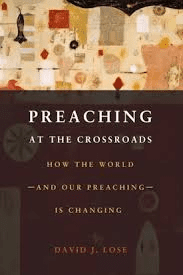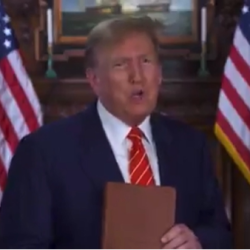I rarely finish a non-fiction book, except under duress of the grading system (and in that regard, I’ve been a free woman for more than a decade!) So the fact that I willingly read through David Lose’s Preaching at the Crossroads is its own kind of recommendation. But it recommends itself in other ways, too.
In short, this is the preaching book you WISH someone had written when you were in seminary (under duress of the grading system, as it were). I recall reading stuff the size and shape of a doorstop—books that, in fact, would be put to better use as an actual door stop. Lose’s new book transcends the sometimes stiff and didactic approach to preaching, and frames a narrative that is life giving, hope filled, and inspired.
On the whole, the book is conversational, much like his popular blog, Working Preacher. The engaging tone makes for an enjoyable read; but it’s the content of the conversation that has the power to change how we preach—and maybe even how we approach church—in our time and place. Lose acknowledges the massive culture shifts taking place in and around our churches, and gathers those challenges into a philosophy of preaching in a way that, to my knowledge, no one else has managed to do. He recognizes—and rejects—the impulse to approach this new age of preaching as a problem to be solved. Instead, he offers ways of drawing our new, emerging reality into the sermon itself.
Lose grasps the difficulty of preaching to quickly shifting demographics in a way that few other theologians and scholars are able to articulate. And—here’s the best part—he never once uses the word ‘millennials!’ Rather than bemoaning the exodus of ‘young people’ from Church, Lose takes a much broader, multi-layered look into all the ways the church is losing ground in people’s lives. Then he examines how we, as pastors and preachers, might insert the gospel back into a central place of relevance for those with whom we do ministry, and in the culture at large.
In the section on ‘vocation,’ he shares some creative (some might say radical) approaches to doing just that—meeting people where they are, and bringing the gospel to their every day realities. If we take him seriously, this conversation might just change the way we preach—and the way our sermons are heard.
Preaching at the Crossroads offers a healthy balance of the academic and the anectdotal; the practical and the theoretical; the theological and societal; and the big picture in conjunction with our smaller contexts. In other words—for a small book, it does a lot of work. And throughout the whole work runs the thread of the biblical narrative; bringing the reader back to the center of who we are in Christ, and reminding us why we do this work of speaking good news into the darkness.
I don’t know that I’d recommend this read, as a whole, for a much larger audience than preachers, seminary students, and professors. However, sections of the book would make for helpful discussions in larger faith-based settings.
At the center of Lose’s argument lies, ultimately, a call to hope. He extends this call not just to preachers, but to all who believe in the power of the gospel to overcome whatever threat, uncertainty, or struggle the world may present. In his own words: “The key to offering a compelling witness to the transcendent hope at the heart of Christianity rests in reclaiming the distinctive character of the story in which that hope is rooted.”
For me, that sums up the discussion concisely. We do, in fact, stand at a crossroads—in preaching and in the life of faith. The way forward can be rooted in fear and anxiety, hanging onto our own answers and ‘fixes;’ or it can be guided and shaped by the hope of our greater story.
Guess which way has better sermons?

















